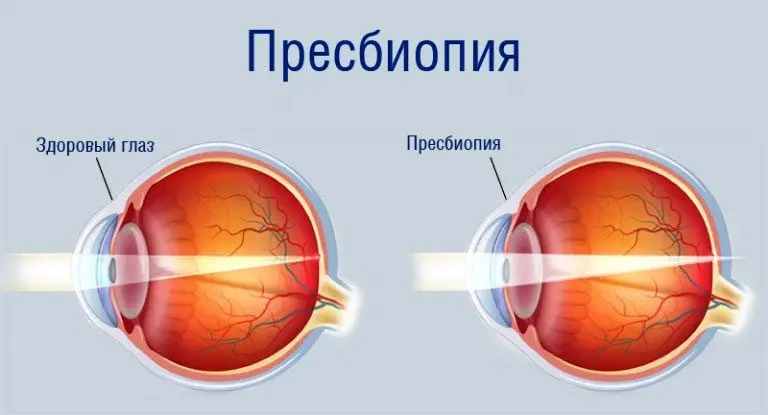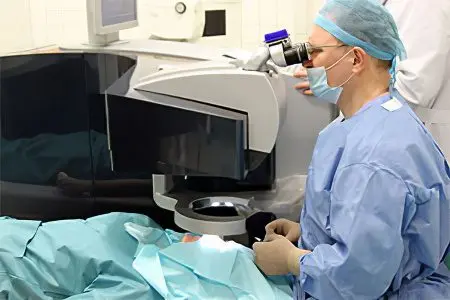
Clear vision is the key to an objective and complete perception of the world around us, with all its beauty and uniqueness. This is why declining eye health is always such a big concern. With age, almost all people inevitably face the problem of fuzzy visualization of objects located at close range, even if their eyes have worked flawlessly throughout their lives. The reason for this is the natural process of aging and wear and tear of our body, an integral part of which is the visual apparatus.
Presbyopia, or senile farsightedness, is a violation of the acuity of near vision, combined with the preservation of the ability to see distant objects clearly. It is this pathology that differs from true hypermetropia, at high degrees of which people see poorly at any distance. The reason is that the rays of light passing through the optical media of the eye are not refracted enough, so their focus is located behind the retina, and not exactly on it, as in healthy vision. A special adaptive mechanism helps to correct this situation – accommodation, that is, a change in the curvature of the lens. But the older the person, the less his accommodative resource.
Age-related farsightedness develops the earlier, the more actively the near vision was exploited, and the more it was initially impaired. But usually even perfectly healthy people at the age of 40-45 begin to notice that it is difficult for them to focus on nearby objects for a long time, read texts written in small print, and perform painstaking precise work. Many questions arise: is presbyopia inevitable, how to stop the progressive deterioration of vision, is it possible to cure age-related farsightedness or at least slow down its development? We will tell you about all this today.
What is presbyopia?
The “senile eye” (presbyopia) is characterized by a loss of visual acuity near, already at a distance of 25-30 centimeters from the face, while more distant objects are seen quite clearly. This encourages older people to move books and newspapers away from them when reading, to take a step back from too small inscriptions and advertisements on the walls in order to be able to view them from a comfortable distance of 50-60 cm.

Causes
This visual impairment occurs primarily due to the loss of the lens of its elasticity. Our organic biconvex lens, necessary for adjusting the focal length, is updated throughout life. A healthy lens is filled with special transparent fibers and easily changes its curvature with the help of the efforts of the ciliary muscle. This ensures the ability to clearly see objects both near (expansion) and far away (flattening). But with age, the fibers inside the lens clump into a dense core, which gradually sclerosis, which prevents the flexibility of the lens. Another cause of the problem is the simultaneous wear of the ciliary muscle and the ciliary girdle – the lens control elements.
The reasons for the early, accelerated development of age-related farsightedness are the following negative factors:
Pre-existing hypermetropia, especially medium (from +3 to +5) or high (more than +5) degree. With such a pathology, during life, the eye muscles are constantly tensed, the accommodation resource is mercilessly exploited, and therefore is depleted faster;
Eye injury (burns, bruises, wounds) and inflammatory diseases (conjunctivitis, blepharitis, keratitis);
Professional predisposition – work as a programmer, photographer, jeweler, welder, and in general any kind of activity associated with a harmful effect on the eyes (bright flashes, dust, temperature changes, radiation exposure);
Associated chronic diseases – hypertension, osteochondrosis and hernia of the cervical spine, neurological pathologies, diabetes mellitus, dysfunction of the thyroid gland and pituitary gland, alcoholism.
Symptoms

The characteristic signs of age-related farsightedness include the following factors:
Slowly progressive deterioration in near visual acuity;
Increased need for good workplace lighting;
Merging and / or doubling of letters after 20-30 minutes of continuous reading;
Blurring of contours when quickly shifting your gaze from a near object to a distant one;
Burning, cutting, itching, lacrimation, photophobia, feeling of sand poured into the eyes as a result of prolonged visual strain. Dizziness and headaches are also possible, bursting sensations in the eyebrows, bridge of the nose and eyeballs.
Diagnostics
To confirm the presence of age-related farsightedness in a patient, assess its degree and develop treatment tactics, an ophthalmologist may need the following procedures:
Visometry – a simple test, during which the patient needs to see from a distance letters of different sizes, depicted in rows on a poster. Typically, the study is carried out using trial “plus” lenses;
Refractometry – measurement of clinical refraction indices of the eyes using a special electronic device – a refractometer;
Ophthalmoscopy – examination of the fundus using an ophthalmoscope or fundus lens to assess the condition of the retina, optic nerve, vascular network and other important components of the visual apparatus;
Tonometry – measurement of intraocular pressure. Its persistent increase signals the risk of developing glaucoma;
biomicroscopy – examination of the internal structure of the eyes using a special slit lamp;
Accommodation study – a group of tests, which include the determination of its relative and absolute volumes, as well as proximetry, ergography and accommodometry.
Video with Elena Malysheva about age-related farsightedness, lenses and vision correction
Laser correction and eye microsurgery

Let’s move on to radical methods of restoring visual acuity after 40 years:
Thermokeratoplasty – the operation consists in applying pinpoint burns with a hot needle along the periphery of the cornea. Because of this, after a while the cornea contracts in places of cauterization, respectively, it becomes more convex, and its refractive power increases. The focus returns to the retina, the manifestations of age-related farsightedness go away. For the same purpose, a more modern, laser technology is used, where a narrow beam acts instead of a needle;
Photorefractive keratectomy (PRK) and laser keratomyelosis (LASIK, LASEK, Epi LASIK, Super LASIK, etc.) – various types of procedures for “evaporating” the middle layers of the cornea in the right places using an excimer laser. When these methods are used to treat age-related farsightedness up to +5 diopters, the top layer is removed from the cornea and folded to the side in the form of a “cap”, the middle layers are subjected to ablation along the periphery, and then the “cap” is returned to its place. The effect of the operation is the same as described in the previous paragraph, however, rehabilitation takes less time, the risk of complications is much lower;
Implantation of phakic intraocular lenses (PIOL). This method of surgical treatment of farsightedness is relevant for patients with thinned cornea, which is a direct contraindication to laser vision correction. Lenses are inserted into the anterior or posterior chamber of the eye through micro-incisions. It is advisable to do this only if the lens is still working and retains the ability to accommodate;
Lens replacement an artificial analogue is produced with a high degree of age-related farsightedness, after 40 years, when the above methods are already powerless, and the lens has exhausted all resources. It is removed using ultrasound, a procedure called “phacoemulsification”, and an artificial multifocal lens is implanted in this place, which will perform the necessary optical functions.
It can be said about all the listed interventions that they take a minimum of time (5-30 minutes), usually do not require either preliminary or postoperative hospitalization, are performed under local anesthesia and are not accompanied by painful sensations. Rehabilitation lasts from 24 hours to several months, the effectiveness is also different – someone helps to completely restore visual acuity, someone only partially, and some people complain about the further aggravation of the disease or even the emergence of new problems.
Автор статьи: Дегтярева Марина Витальевна, врач-офтальмолог, окулист









